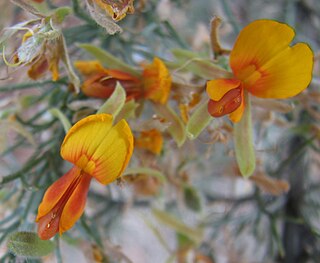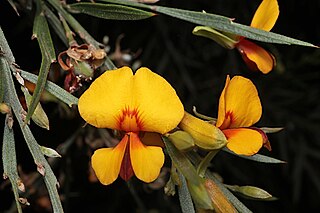
Jacksonia furcellata, commonly known as grey stinkwood, is a species of flowering plant in the family Fabaceae and is endemic to the south-west of Western Australia. It is a prostrate to low-lying, or weeping erect shrub with greyish-green branches, sharply-pointed side branches, its leaves reduced to scales leaves, yellowish-orange flowers, and woody, hairy pods.

Jacksonia horrida is a species of flowering plant in the family Fabaceae and is endemic to the south-west of Western Australia. It is an erect or spreading to prostrate, bushy shrub with greyish-green branches ending in short, flattened, sharply-pointed side branches, the leaves reduced to scales and the flowers scattered and yellow-orange with red markings.

Jacksonia acicularis is a species of flowering plant in the family Fabaceae and is endemic to the west of Western Australia. It is an erect, spindly shrub with very sharply-pointed short side branches, leaves reduced to scales, orange flowers with red markings, and densely hairy pods.

Jacksonia aculeata is a species of flowering plant in the family Fabaceae and is endemic to the northern Australia. It is a spreading shrub with sharply-pointed, hairy, short side branches, leaves reduced to scales, lemon-yellow flowers, and woody, hairy pods.

Jacksonia alata is a species of flowering plant in the family Fabaceae and is endemic to the south-west of Western Australia. It is a tufted, semi-prostrate to erect shrub with flattened branches, sharply-pointed side branches or phylloclades, leaves reduced to narrowly lance-shaped scales, yellow-orange flowers with a red "eye", and woody, densely hairy pods.

Jacksonia arenicola is a species of flowering plant in the family Fabaceae and is endemic to the south-west of Western Australia. It is an erect, broom-like shrub with densely hairy, sharply-pointed phylloclades, yellow-orange flowers with red markings, and woody pods that are hairy at first, later glabrous.

Jacksonia argentea is a species of flowering plant in the family Fabaceae and is endemic to the far north of Western Australia. It is an erect, silver-grey shrub with flattened, narrowly lance-shaped to narrowly elliptical cladodes or phylloclades, bright yellow flowers, and woody hairy pods.

Jacksonia calcicola is a species of flowering plant in the family Fabaceae and is endemic to the south west of Western Australia. It is a prostrate spreading or erect, prickly shrub with short, curved backwards and sharply pointed end branches, yellow-orange flowers with red markings, and woody, hairy pods.
Jacksonia calycina is a species of flowering plant in the family Fabaceae and is endemic to the south west of Western Australia. It is an erect or straggling shrub with sharply pointed end branches, yellow-orange flowers with red and yellow markings, and woody, hairy pods.

Jacksonia capitata is a species of flowering plant in the family Fabaceae and is endemic to the south of Western Australia. It is a spindly, low-lying to erect ascending shrub with curly, greyish green, cylindrical branches, the leaves reduced scales, and yellow-orange and red flowers in clusters at the ends of the shoots.

Jacksonia compressa is a species of flowering plant in the family Fabaceae and is endemic to the south west of Western Australia. It is an erect, bushy shrub with sharply pointed end branches, yellow-orange flowers with red markings, and woody, hairy pods.

Jacksonia cupulifera is a species of flowering plant in the family Fabaceae and is endemic to the north-west of Western Australia. It is an erect shrub or weeping tree with sharply-pointed phylloclades, its leaves reduced to scales and yellow-orange flowers scattered along the branches.

Jacksonia debilis is a species of flowering plant in the family Fabaceae and is endemic to the south west of Western Australia. It is a spreading to prostrate shrub with curved phylloclades, yellow-orange flowers with red markings, and woody, hairy pods.
Jacksonia dendrospinosa is a species of flowering plant in the family Fabaceae and is endemic to the far west of Western Australia. It is a dense, erect shrub or tree with straight, sharply-pointed branches, leaves reduced to scales, scattered yellow-orange flowers with red markings, and membranous, hairy pods.

Jacksonia elongata is a species of flowering plant in the family Fabaceae and is endemic to the south of Western Australia. It is an erect or spreading, spindly shrub with yellowish-green branches, yellow-orange flowers with red markings, and woody, densely-hairy pods.
Jacksonia foliosa is a species of flowering plant in the family Fabaceae and is endemic to the south west of Western Australia. It is a low-lying or erect shrub with sharply pointed end branches, yellow-orange flowers with red markings, and woody, hairy pods.

Jacksonia forrestii, commonly known as broom bush, is a species of flowering plant in the family Fabaceae and is endemic to the north-west of Australia. It is an erect, slender, weeping shrub or tree with sharply pointed phylloclades, yellow to yellow-orange flowers without markings, and woody, hairy pods.

Jacksonia gracillima is a species of flowering plant in the family Fabaceae and is endemic to the south-west of Western Australia. It is a low, spreading, compact shrub with greyish-green branches, yellow to yellow-orange or orange-red flowers with red markings, and woody, densely-hairy pods.

Jacksonia hakeoides is a species of flowering plant in the family Fabaceae and is endemic to the south west of Western Australia. It is a low, densely-branched shrub with sharply-pointed end branches, the leaves reduced to scales, yellow-orange to orange flowers with red markings, and woody, densely hairy pods.
Jacksonia intricata is a species of flowering plant in the family Fabaceae and is endemic to the south of Western Australia. It is a domed, tangled shrub with copper-coloured branches when fresh, the end branches sharply-pointed, the leaves reduced to scales, yellow flowers with red markings, and woody, densely hairy pods.
















